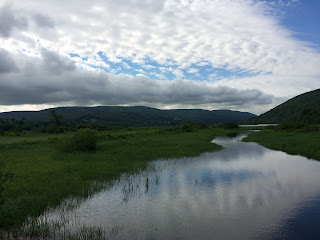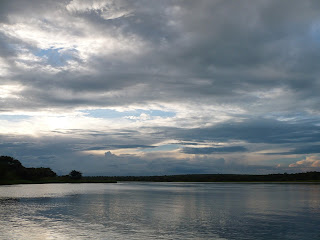 |
| "In Between Nests" by Merrill Comeau |
I'm cherishing my inner river right now because I see it clear as day, and there's much I don't see clearly in my inner landscape.
Headwaters
Of late, I've been thinking about inner landscapes, so much so that I posted an invitation to my Facebook friends to share possible inquiry questions about them.*** The questions they've posted have already stimulated my thinking, and I'm looking forward to focusing on a few of them first. Some of their questions have asked for descriptive, personal answers: What do you see when you look at your inner landscape? Hence this blog.
The River Blog Forks Briefly
Saturday afternoon, after I said to myself, "A river runs through my inner landscape," I recalled that I had a copy of Norman Maclean's novella "A River Runs Through It." Saturday night, I read it.
I loved it. It's a great story, a humbling story. It asks the question of how people help other people, especially when there's history--personal, familial, cultural--that complicates attempts at communication and action. As such, it's a story for our time in which so many people are saying they want to help. I'm thinking especially about the White people I've been speaking to or reading about who've been saying they want to know how to be active antiracists.****
So since I want to get back to the topics of rivers and the role of inner landscapes, which may in part be to help, I am simply going to provide you with this conversation between the narrator and his minister father about trying to help the narrator's enigmatic, somewhat rebellious brother.
"'Help,' he [the father] said, 'is giving part of yourself to somebody who comes to accept it willingly and needs it badly.
Drawing by Scott Ketcham 'So it is,' he said . . ., 'that we can seldom help anybody. Either we don't know what part to give or maybe we don't like to give any part of ourselves. Then, more often than not, the part that is needed is not wanted. And even more often, we do not have the part that is needed. . . ..'"I told him, 'You make it too tough. Help doesn't have to be anything that big.'He asked me, 'Do you think your mother helps him by buttering his rolls?''She might,' I told him. 'In fact, yes, I think she does.''Do you think you help him?' he asked me.'I try to," I said. "My trouble is I don't know him. In fact, one of my troubles is that I don't even know whether he needs help. I don't know, that's my trouble.''That should have been my text,' my father said. 'We are willing to help, Lord, but what if anything is needed?'' (81-82)*****
I would paraphrase that last line as "Please, God, let there really be no reason I need to help; please don't let me need to do anything more or different than what I'm already doing." I've had the feeling.
The River Blog Fork Rejoins the Main Flow--With Reverence
The minister father and his two sons share a love for fly-fishing, especially on Montana's Blackfoot River, which they also love; and they know rivers in a way I don't and suspect I never will. But that doesn't mean I can't revere rivers, and I do.
 |
| Dordogne in Beynac |
But nothing in all of my travels thrilled me more than seeing the Nile River in 2008.
It was very late afternoon. And frankly, I hadn't expected to see the Nile on my way to Murchison Falls National Park in Uganda. In fact, I'd never expected to see the Nile in my lifetime. And then there it was, spreading out before me, as old as time.
As afternoon reached toward sunset, I heard the words "ancient, dusky rivers" in my mind's ear. I'd taught Langston Hughes' "The Negro Speaks of Rivers" many times, and now here I was, so close to one of those rivers that had deepened the soul of Hughes' archetypal Black narrator who spoke from a perspective shaped by all geography and human history. I felt that poem with a new intensity.
The River Blog Forks Again, Draws Toward a Langston Hughes Poem
Hughes' poem was among those featured in the American Academy of Poets #shelterinpoems virtual poetry reading in late April, and classical soprano Julia Bullock read it. Not surprisingly, Bullock's speaking voice is beautiful, so listening to her read the poem (at minute 30:10) and share the story behind it (at minute 27:16) is as soothing an auditory experience as it is a deeply moving literary one.
The Negro knows rivers for good reason: he's had life experiences with the Euphrates, the Congo, the Nile, and the Mississippi--those major rivers that shaped civilization, civilized or not. We the readers move with him from dawn (on the Euphrates) to sunset (on the Mississippi) and feel that weighty human history as one long day.
I bathed in the Euphrates when dawns were young.I build my hut near the Congo and it lulled me to sleep.I looked upon the Nile and raised the pyramids above it.I heard the singing of the Mississippi when Abe Lincolnwent down to New Orleans, and I've seen its muddybosom turn all golden in the sunset.
Such a long day, filled with raising and building in servitude, but also with bathing and lulling and sleeping and singing. All spring, I've been thinking about the emotional effect of repetition in poetry. Could we feel the Negro's transcendent groundedness without Hughes' repetition of "I've known rivers" and "My soul has grown deep like the rivers"? Truthful repetitions comfort and assure, even when the stories they relate to are fraught with struggle and uncertainty.
The River Blog Wanders Back to "A River Runs Through It"
Rivers flow, even when they seem still. And according to Norman Maclean, rivers speak, though we may not understand them.******* In fact, the father in "A River Runs Through It" sees rivers and words in relationship to each other, though the nature of that relationship has eluded him at times.
As the father explains to one of his sons, who comes upon him as he's rereading the first chapter of the Gospel According to John, "'I used to think the water was first, but if you listen carefully you will hear that the words are underneath water'" (95). When his son disagrees, he says, "'No,' . . . . 'you are not listening carefully. The water runs over the words.'" (96).
Interestingly, he says this after a long passage in which that same son has talked about listening to the river's different voices.
 |
| The Margaree River, Cape Breton, Nova Scotia |
A river that was busy taking care to respect both of its banks? A river that was re-speaking in order to be sure it understood what it itself had just said? A river with voices formed of words and water in some sort of a relationship? And how about, in a later passage, "A river . . . [that] has so many things to
say that it is hard to know what it says to each of us" (102)?
Clearly I have much to learn about rivers.
And Finally, This River Blog Wanders Back to "Inner Landscapes"
My inner landscape doesn't specifically contain any of the actual rivers I've named or referred to above, though I'm sure the river running through it reflects each of them somehow. It's more an archetypal river that I see in my mind's eye; it appears more sketched or painted than photographed. Maybe that's because my husband is an artist; maybe it's because my inner landscape is more dreamscape than landscape.
And that may be the case for everyone. According to The Power of Myth, when Bill Moyers asked Joseph Campbell about the difference between a myth and dream, Campbell explained that "a dream is a personal experience of that deep, dark ground that is the support of our conscious lives, and a myth is the society's dream. The myth is the public dream and the dream is the private myth" (40).******
 |
| Drawing by Scott Ketcham |
But inner rivers can't do it all on their own. Too often, it's a failure of imagination masquerading as a desire for clarity that holds us back from heeding our inner rivers and letting ourselves know what we actually already know--which is where we need to go. That's why I loved it when Norman Maclean said, "At sunrise, everything is luminous but not clear." Intent on identifying the clear, we often overlook the
luminous, which is so important if, as Campbell says, "we are looking
for . . . a way of experiencing the world that will open to us the
transcendent that informs it, and at the same time forms ourselves
within it. That is what people want. That is what the soul asks for"
(53).*********
 |
| Drawing by Scott Ketcham |
My metaphorical river knows this, and is challenging me to wade into it and write more of my own poetry, humbled as I am by the great poems I've been reading, listening to, and living by.
Meanwhile my husband keeps unintentionally showing me to myself in some of the drawings he's been doing. Sometimes, it seems to me that a river runs through them. He's excited that I'm drawn to mythic and metaphorical rivers, whether or not he's actually drawing them. He encourages me to wade in and swim. That he believes I can do this and stick with it helps.
Since poems seem so alive to me, I can't think of a better aspiration for me than "to see life as a poem and . . . [myself] as participating in a poem . . . " (55). So here goes.
The Writer Wades in and Writes a Draft Poem💙
The Reader Speaks of Rivers
--with gratitude to and for Langston Hughes
I've known rivers.
I've known rivers rendered in words that pooled in my heart and mind, then carried me beyond them.
My soul's been infused with those rivers.
sylvan Wye with a
boy-turned-man, and
heard the still, sad
music of humanity.
I've followed the sacred
river Alph into measure-
less caverns and
glimpsed a savage
place enchanted.
I've moved among city-
dwellers oblivious to a
strong brown god that
flowed implacable,
waiting, watching and
waiting.
I've planted myself on the
banks of the singing
river, beside the rock
and the tree, and
embraced the new
hour holding new
chances.
I've known rivers.
Mapped, metaphorical, mythic rivers.
My soul's been infused with those rivers.
[💙Note: All words and lines drawn from the poems the reader has read are italicized.]
__________
* From Merrill Comeau's "Tree Pieces": Painted Fabric Collages by Merrill Comeau, displayed at Hunnewell Visitor Center at the Arnold Arboretum in 2011. I believe this piece is called "In Between Nests," and it may not contain a river, but I seem to see one. https://patch.com/massachusetts/jamaicaplain/tree-pieces-painted-fabric-collages-by-merill-comeau
** Eliot, T.S. (1970). T.S. Eliot: Collected poems 1909-1962. New York: Harcourt, Brace, & World.
*** Those who've participated have actually been doing the step of the Right Question Institute's Question Formulation Technique (QFT) that asks participants to generate questions about a Question Focus (or QFocus)--in this case, "inner landscapes."
**** This word is in the title of Ibram Kendi's latest book, How to Be an Antiracist.
**** This word is in the title of Ibram Kendi's latest book, How to Be an Antiracist.
***** Maclean, N. (1976). A river runs through it. Chicago: University of Chicago Press.
*(6) Photograph included in the following blog: Waddell, T. (2010). Awaken to Beynac, in the Perigord/Dordogne, France [web log post]. Retrieved from https://myfrenchawakening.wordpress.com/2010/05/14/awaken-to-beynac-in-the-periograddordogne-france/
*(7) Screen shot of an image on https://quotefancy.com/quote/1307419/Norman-Maclean-We-can-love-completely-what-we-cannot-completely-understand
*(8) Campbell, J., & Moyers, B. (1988) The power of myth: With Bill Moyers. New York: Doubleday.













